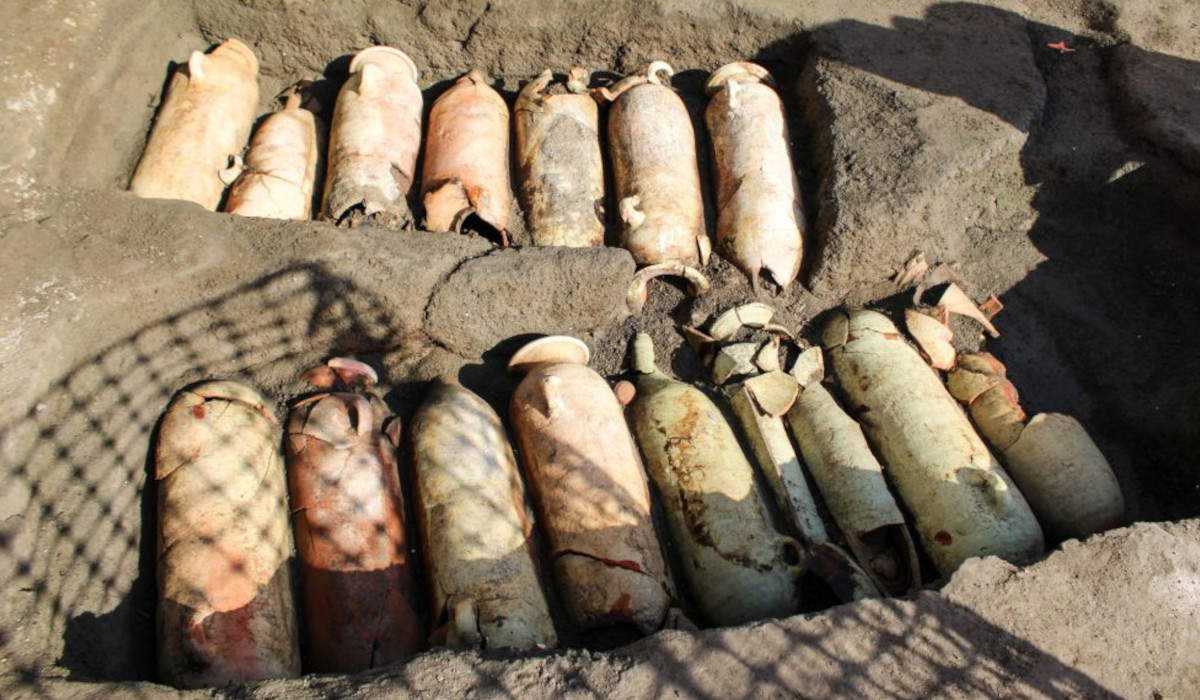As part of the works for the “Modernization of the Circumvesuviana and Urban Compatibility Interventions of the Railway Line of the Municipality of Pompeii,” during the construction of an underground parking lot in Via Fucci in Pompeii, behind the Pompeii Santuario train station, a pre-Roman necropolis was discovered covering a chronological span from the 3rd to the 1st century B.C. At the present state of knowledge, there are 35 burials. These are inhumations in simple earthen pits, semicappuccine or covered with amphorae (all of North African import, some with Punic language stamps, and placed in alternating neck/tip, in recurring number of 7), characterized by the presence of few grave goods, mainly unguentarians and coins, and by an excellent state of preservation of the osteological finds thanks to the ’immersion of the burials in groundwater, which allowed a paleo-anthropological survey campaign to be initiated on the remains.
Following these findings, Superintendent Mariano Nuzzo declared “the need to continue and further expand the area of investigation in order to complete the cognitive framework of the necropolis and delineate the physiognomy of the ancient landscape that characterized the eastern suburbs of Pompeii, about which little is still known. Thanks to preventive archaeology and the synergistic action between the Superintendency, the Municipality and the EAV, which has made it possible to share procedures and objectives, important results are being achieved in the protection and enhancement of an area of crucial historical and archaeological importance. We expect to share new data from the continuation of the excavations shortly.”
The area in which the work was to be carried out, for which the then Pompeii Superintendent’s Office had issued a favorable opinion back in 2007, which was reconfirmed by the Special Superintendent of Naples and Pompeii in 2009 and 2010, had already been affected by preliminary investigations, mainly geoarchaeological coring and trenching, due to the discovery of levels from 79 AD.C. at depths greater than 6 meters from the current ground level and immersed in the water table. As of spring 2023, under the direction of the Superintendence for the Naples Metropolitan Area, recent excavations have confirmed the presence of extensive plowed fields perfectly preserved under the thick blanket of pumice from the great Vesuvian eruption of 79 AD.: a system of ancient furrows and pits oriented in a N-S direction and set directly on the protohistoric levels, with cultivation mainly of vegetables, which supplied the Pompeian markets every day, close to the route of the ancient Sarno River, which must have been much closer to the city than it appears today. Macroresti and pollen analyses are underway to define in detail the type of vegetable cultivated, although the size of the surface remains, the type of distribution and the size of the root systems, already suggest fields cultivated with multi-year artichoke plants. Once the containment works were carried out, thanks to the use of water pumps, control assays were performed at about -7.50 meters from ground level in correspondence with the subservices functional to the garage. Here a channel was identified, paleoalvee of anthropogenic origin with N-S trend within which material of different nature pertaining to probably devastated funerary contexts was collected: hundreds of tile fragments, a large quantity of dolia and amphorae fragments, about 20 columellae made of local lava stone that had been broken up in ancient times and accumulated in the channel already at a stage prior to the setting of the Roman plowed fields, tiles with Oscan language stamps, wooden finds of considerable size. A female head was also found in gray Campanian tuff with traces of red in the hair style. It is likely that the channel, which is mostly characterized by materials pertaining to devastated funerary contexts, can be attributed to the territorial reorganization of the Sillan age, which took place after the colonial dedication of Pompeii in 89 BC. Investigations are still ongoing, as are archaeobotanical and paleoanthropological analyses, with a view to multidisciplinary documentation of the archaeological context that is returning data of interest.
 |
| Pompeii, pre-Roman necropolis unearthed during work to build parking lot |
Warning: the translation into English of the original Italian article was created using automatic tools. We undertake to review all articles, but we do not guarantee the total absence of inaccuracies in the translation due to the program. You can find the original by clicking on the ITA button. If you find any mistake,please contact us.